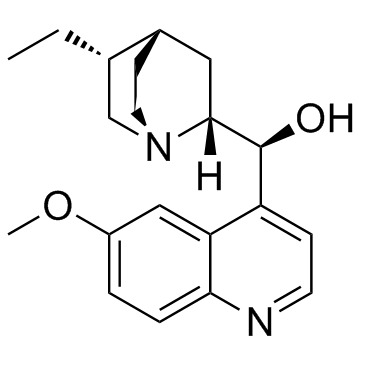Hydroquinidine

Hydroquinidine structure
|
Common Name | Hydroquinidine | ||
|---|---|---|---|---|
| CAS Number | 1435-55-8 | Molecular Weight | 326.433 | |
| Density | 1.2±0.1 g/cm3 | Boiling Point | 498.4±30.0 °C at 760 mmHg | |
| Molecular Formula | C20H26N2O2 | Melting Point | 169-170 ºC | |
| MSDS | Chinese USA | Flash Point | 255.2±24.6 °C | |
| Symbol |

GHS07 |
Signal Word | Warning | |
|
Design and application of an in vivo reporter assay for phenylalanine ammonia-lyase.
Appl. Microbiol. Biotechnol. 97(17) , 7877-85, (2013) Phenylalanine ammonia-lyase (PAL) is an important enzyme that links primary metabolism to secondary metabolism. Its efficiency is often a critical factor that affects the overall flux of a related metabolic pathway, the titer of the final products, and the ef... |
|
|
Macromolecular crowding-assisted fabrication of liquid-crystalline imprinted polymers.
Anal. Bioanal. Chem 407(10) , 2923-31, (2015) A macromolecular crowding-assisted liquid-crystalline molecularly imprinted monolith (LC-MIM) was prepared successfully for the first time. The imprinted stationary phase was synthesized with polymethyl methacrylate (PMMA) or polystyrene (PS) as the crowding ... |
|
|
A (p)ppGpp-null mutant of Haemophilus ducreyi is partially attenuated in humans due to multiple conflicting phenotypes.
Infect. Immun. 82(8) , 3492-502, (2014) (p)ppGpp responds to nutrient limitation through a global change in gene regulation patterns to increase survival. The stringent response has been implicated in the virulence of several pathogenic bacterial species. Haemophilus ducreyi, the causative agent of... |
|
|
Mutational analysis of the (p)ppGpp synthetase activity of the Rel enzyme of Mycobacterium tuberculosis.
Arch. Microbiol. 196(8) , 575-88, (2014) Rel(Mtb), a GTP pyrophosphokinase encoded by the Mycobacterium tuberculosis (Mtb) genome, catalyzes synthesis of (p)ppGpp from ATP and GDP(GTP) and its hydrolysis to GDP(GTP) and pyrophosphate to mediate stringent response, which helps bacteria to survive dur... |
|
|
Pulmonary impairment, not muscle injury, is associated with elevated ESR in the idiopathic inflammatory myopathies.
Rheumatology (Oxford.) 52(7) , 1336-8, (2013)
|
|
|
A novel selection marker for efficient DNA cloning and recombineering in E. coli.
PLoS ONE 8(2) , e57075, (2013) Production of recombinant DNA in bacterial cells is an essential technique in molecular biology. Plasmids are usually maintained in an E. coli host by antibiotic selection. However, there are only a few antibiotic-resistance markers available in common use. H... |
|
|
Evidence for a catalytically and kinetically competent enzyme-substrate cross-linked intermediate in catalysis by lipoyl synthase.
Biochemistry 53(28) , 4557-72, (2014) Lipoyl synthase (LS) catalyzes the final step in lipoyl cofactor biosynthesis: the insertion of two sulfur atoms at C6 and C8 of an (N(6)-octanoyl)-lysyl residue on a lipoyl carrier protein (LCP). LS is a member of the radical SAM superfamily, enzymes that us... |
|
|
Ketoacyl synthase domain is a major determinant for fatty acyl chain length in Saccharomyces cerevisiae.
Arch. Microbiol. 195(12) , 843-52, (2013) Yeast fatty acid synthase (Fas) comprises two subunits, α6 and β6, encoded by FAS2 and FAS1, respectively. To determine features of yeast Fas that control fatty acyl chain length, chimeric genes were constructed by combining FAS sequences from Saccharomyces c... |
|
|
Microbial production of short-chain alkanes.
Nature 502(7472) , 571-4, (2013) Increasing concerns about limited fossil fuels and global environmental problems have focused attention on the need to develop sustainable biofuels from renewable resources. Although microbial production of diesel has been reported, production of another much... |
|
|
A ferrofluid-based homogeneous assay for highly sensitive and selective detection of single-nucleotide polymorphisms.
Chem. Commun. (Camb.) 49(73) , 8114-6, (2013) A simple and low-cost colorimetric assay utilizing ferrofluidic nanoparticulate probes (FNPs) and a ligase for single-nucleotide polymorphism genotyping is described. Excellent sensitivity and selectivity were accomplished through the engagement of the FNPs a... |